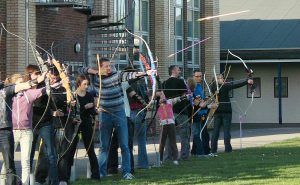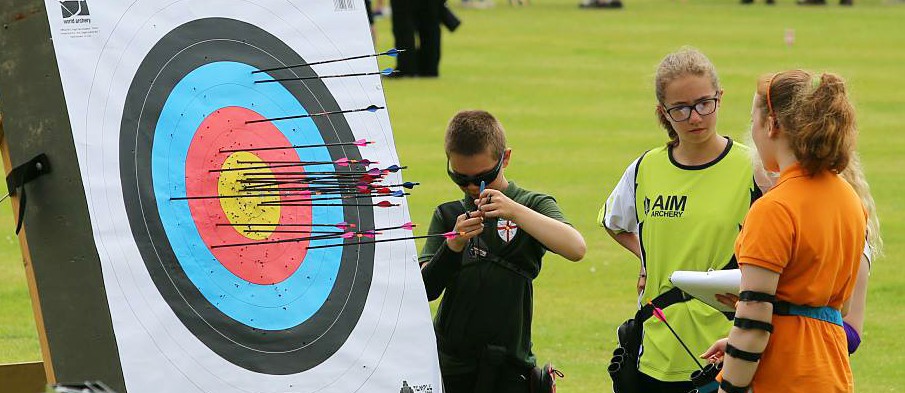Lesson times
Beginners Courses are supervised by certified Coaches, and follow the six-module structure recomended by the national archery coaching panel.
BECAUSE OF COVID-19 Restrictions we did make some temporary changes: Instead of the 3-Saturdays format described below, we have been giving 4 modules over two days, on two mornings with a week’s gap between, followed later on with a further morning to deal with the final two modules. The first two mornings deal with Shooting Skills and Safety, and the later top-up session deal with mostly technical and Sport-related topics. This scheme actually worked very well, and we may continue to follow it at least some of the time. If after taking the two-day course you’d like to join the Club, you’ll find you get much more out of the top-up day after you’ve had some experience shooting at the club range. In Summer some of the courses will be held outdoors, so we may have to make last minute changes if the weather is unsuitable.
Normally Lessons will mostly be on three consecutive Saturdays, each comprising two 90 minute Sessions, with a Refreshment Break, in Summer the lessons are usually from 11.00am to 2.30pm,outdoors; in Winter, 2.30pm to 6.00pm, indoors
The lessons held indoors aren’t governed by the weather, but if possible at least one session will be outdoors to give an idea of what it feels like to shoot longer distances in the open air – which is what Archery is meant to be about. See our Facilities Page.
If you haven’t seen it already, we recommend reading through the Training Page, which will give an idea of cost and availablility of Courses
SEE ALSO Have-A-Go Days
Applying to take a Course
Please contact us to get your name on the waiting list.
What to bring to your lessons
 Apart from contact information (if you have been sent forms to fill in before you started, otherwise fill in the forms when you arrive) and your payment (or Voucher if someone has bought you a course of lessons), all we ask is that you wear something fairly close-fitting on your upper body – such as a sweat shirt. Please don’t wear floppy sleeves or baggy tops unless you’re prepared to take them off – they can get caught in the bow string and ruin your shooting. Wear comfortable flat-heeled shoes or trainers with fairly firm soles, not too springy.
Apart from contact information (if you have been sent forms to fill in before you started, otherwise fill in the forms when you arrive) and your payment (or Voucher if someone has bought you a course of lessons), all we ask is that you wear something fairly close-fitting on your upper body – such as a sweat shirt. Please don’t wear floppy sleeves or baggy tops unless you’re prepared to take them off – they can get caught in the bow string and ruin your shooting. Wear comfortable flat-heeled shoes or trainers with fairly firm soles, not too springy.
It is your responsibility to make sure you aren’t wearing anything attached to you like jewellery or piercings that could get caught in the bowstring, possibly with painful or damaging results.
Age Range
We could flippantly say Eight to Eighty, but we can cope with younger children, and why stop at 80? We will try to help everybody get started and keep going.
There’s a useful FAQ for Parents on the Juniors page.
Aptitude and training
There is no need to be particularly strong to be a good archer, but it is advisable to practice quite frequently. Many ‘club’ archers only shoot once a week, but most mid-level archers would agree that twice a week during the ‘season’ is the minimum required to achieve reasonable consistency. A little more practice time can be enough to raise the archer to County or Regional level – half an hour a day exercise and another hour of shooting every week makes a huge difference. One World Champion and 2-times Olympic medallist claims that most of his most useful practice is done at home with the target 2 metres away! So it isn’t necessary to go to the practice field to make a huge improvement. Archery is very much a Sport For All, and it’s nearly always possible to accommodate disabilities of all kinds.
Equipment and related costs
 Beginners are provided with suitable equipment which is chosen to be easy to use so the beginners are able to control their Bows and not be at the limit of their strength. We do have several different types of bow to try (although we can’t always provide every type to suit every size of beginner).
Beginners are provided with suitable equipment which is chosen to be easy to use so the beginners are able to control their Bows and not be at the limit of their strength. We do have several different types of bow to try (although we can’t always provide every type to suit every size of beginner).
We do let beginners carry on using Club Equipment after they have completed their course of instruction provided it doesn’t conflict with the needs of a beginners’ course. This bridges over until the new members are settled enough to buy their own gear. How long it takes depends on the individual, and whether they are prepared to change equipment in the medium term, because the body does adjust to this unfamiliar activity over a number of months.
We prefer everyone to have their own equipment after the first two months or so, and it’s generally a much better plan if they do. The biggest equipment dealer in the country is only about 35 miles from here, and anyone can go out and spend a fortune at will, but we do try to help by finding second-hand equipment to get people started. If you would like any advice on buying equipment, please feel free to ask the coaches or any of the club members.
Your first set of kit, together with perhaps a new set of arrows is likely to cost in the region of £175 on average. Occasionally it’s possible to find a complete outfit in excellent condition for £100 or so.
A similar intermediate-level set, which in fact would be good enough to compete at County Level, can be had for around £300. The next step up would take you to £600 or even £1500 or more, but there’s no need, or sense, to spend this much early on.
There is an alternative way to familiarise yourself with good equipment, decide whether you want to continue, and develop a bit more strength so the set you eventually buy is the one you will stick with – and that is to HIRE the gear. There is an Archery manufacturer (Stylist Bows) near Guildford who will hire a complete kit for around £50 for three months.
Occasionally there will be bows for sale through the club. Check the Noticeboard for details of any items for sale, or ask a coach.
SEE ALSO Club Activities
 For lots of information about archery, including choosing equipment, setting up equipment, performance tips and competitive shooting, visit our Club and Shooting Information Library.
For lots of information about archery, including choosing equipment, setting up equipment, performance tips and competitive shooting, visit our Club and Shooting Information Library.

